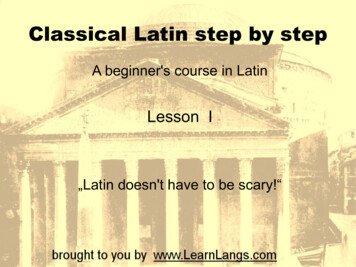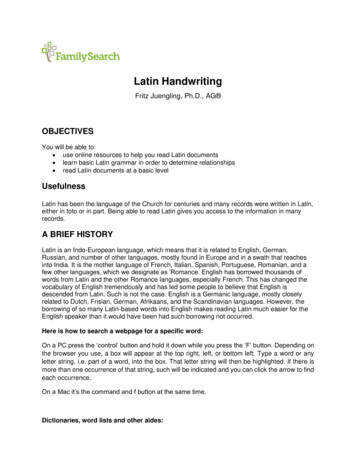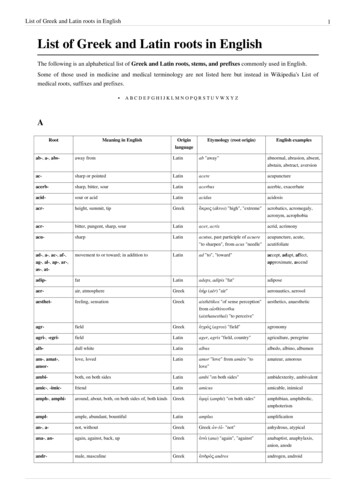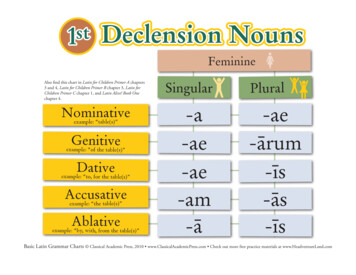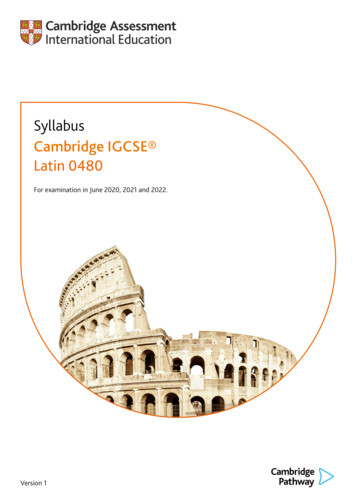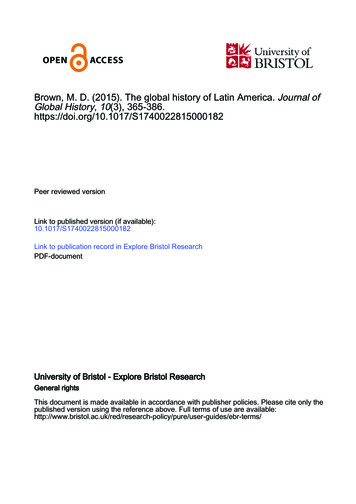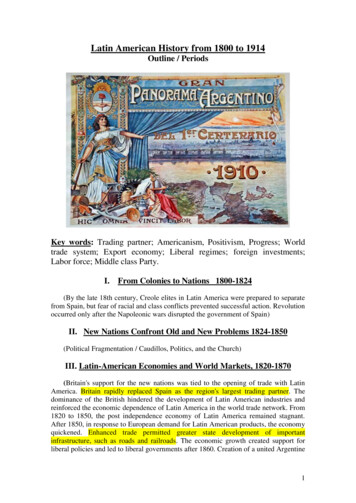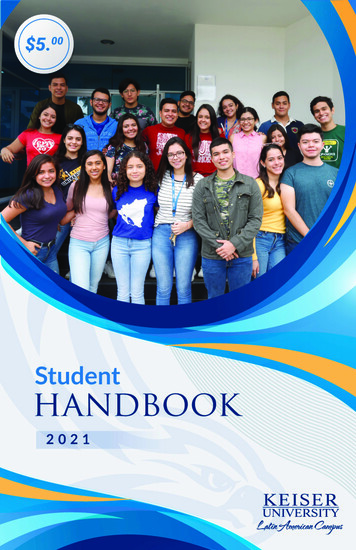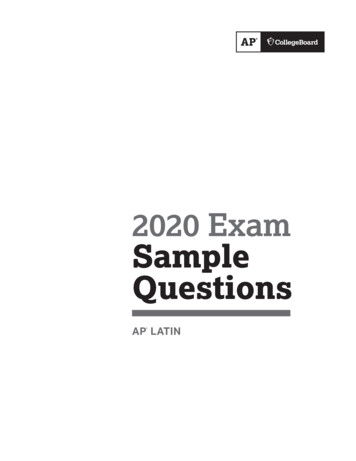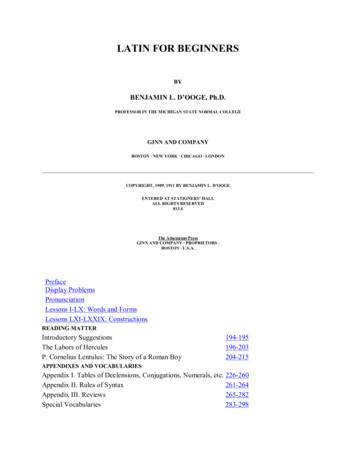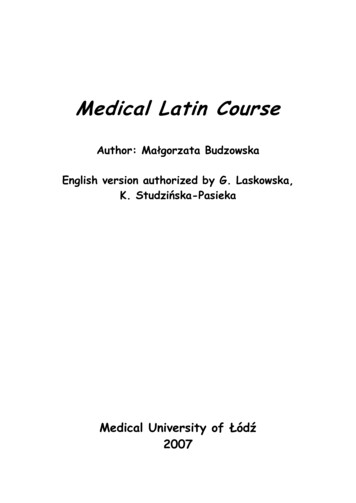
Transcription
Spring 2017 – No. 129Taylor E. MackLouisiana Tech UniversityGuest EditorConference of Latin Americanist GeographersLatin America Specialty Group of the AAGCLAG & LASGNewsletter35th CLAG MeetingMay 21-23, 2018San José, Costa RicaAfter a thirty-year absence, CLAG will return toSan José, Costa Rica, in 2018, for its 35thMeeting. All of the activities of CLAG 2018 willbe held at the Holiday Inn Aurola in downtown,San José. The hotel is just blocks from the PreColumbian Gold Museum, botanical gardens,zoo, and Museum of Contemporary Art andDesign. The discounted roomreservation includes breakfast and lunchthroughout your stay.Planned field trips include day trips of city SanJosé, a tour of coffee plantations andsurrounding volcanoes, and the coastal rainforestat Monte Verde on the Pacific coast. Overnighttrips planned include the Caribbean Lowlands,Manuel Antonio National Park, and the CabécarAlto Chirripó Reserve.Registration will begin in June, 2017, at theMeeting’s website:http://clag2018costarica.ku.edu/Alto Chirripó, site of one of the planned field trips for CLAGin Costa Rica, 2018. Photo by Taylor A. TappanOrganized jointly by the University of Kansas andthe Universidad Nacional de Costa Rica (UNA), likeall CLAG Meetings, this 35th Meeting will offer arelaxed setting in a family-friendly location forgeographic and interdisciplinary intellectual, social,and cultural exchange. Please keep a watch for futureannouncements about CLAG Costa Rica 2018.CLAG Board Nominations & ElectionsBoard members provide advice to the Chair regarding a variety of CLAG affairs (student research awards, CLAGconferences, JLAG, etc.) and are a vital part of keeping CLAG active, engaged and responsive to its membership. EachBoard member is also assigned to one or more of the Standing Committees (Finance, Honors, Publications, andMembership). Please consider nominating yourself or another CLAG member to join the Board. Before nominatingcolleagues, please verify that they are willing to serve if elected. Nominees must be CLAG Members, and may includeoutgoing Board members for reelection, as well as Graduate students, with at least one position reserved for Graduatestudents. All Board members have the same rights and responsibilities as other Board members. Voting will be in earlyJune (watch your email!), with 3-year terms beginning July 1st. Send nominations to Rebecca Clouser, Chair of theMembership Committee at rclouser@wustl.edu Deadline for Nominations: May 26, 2017.
Letter from the CLAG Chair2Dear CLAG Members,For a lot of us, this is the time of year to head to the field. Those doing fieldwork this summer include theten 2017 awardees of CLAG’s Student Field Study Awards (more below). Those four MA and six PhDstudents’ projects exemplify the depth and variety of CLAG scholarship—from post-conflict healing inGuatemala and migrant politics in Costa Rica to ecological restoration in Ecuador’s Andes. We are thrilled tobe able to support such important work.But how does a small organization like ours—228 members at the end of 2016—manage to come up withthe 13,000 we just awarded to these students? Not from our modest membership dues!1 The answer is: ourJournal of Latin American Geography. We may be small, but CLAG boasts an enviably independent, highquality journal. Every time its articles are clicked on or downloaded—whether through Project Muse,JSTOR, or other digital distributor—CLAG earns revenue. We then put that money directly back into theorganization: after covering JLAG’s costs, the next-biggest chunk goes to supporting the next generation ofCLAG scholars. We are particularly pleased to be able to offer fieldwork funding for Master’s students, whocan find it difficult to secure research support. We are also excited to see that the share of students in ourmembership is growing. Please continue to support them by supporting JLAG—as a reader, author, orreviewer!It was a pleasure to see many of you last month in Boston at the AAG meeting—whether at CLAGsponsored sessions, our Board and Business Meetings, or our party at the Brahmin! For me, though, themassive and manic AAG meetings are a great reminder of how important and necessary CLAG’s ownmeetings are. Held every 18 months or so and with participants usually numbering between one and twohundred, our meetings are legendary for their collegiality, great field trips, and stimulating discussions. Ourmeeting in New Orleans last January was a great illustration of this—super paper and poster sessions, andlots of time to talk with each other about our shared interests. Now we have our 35th meeting to look forwardto, in San Jose, Costa Rica, May 21-23rd. Organized jointly by the University of Kansas and the UniversidadNacional de Costa Rica (UNA), expect wonderful accommodations, great fieldtrips, and opportunities forrelaxed and sustained conversations with your colleagues. Like New Orleans, this is also a very familyfriendly destination! (Students: in late Fall of this year, please look out for the opportunity to apply for aStudent Travel Grant to help offset the costs of conference participation.)Finally, some words of thanks. First, to the outgoing Board Members Christian Abizaid, Sarah Blue, J.Christopher Brown, Rebecca Clouser, Richard Hunter, Alexandra Pedersen, Jörn Seemann, and JeffreySmith. All are ending three-year terms of much-appreciated service—whether as newsletter editors,committee members, or proposal evaluators. THANK YOU. The next newsletter you read will be compiledby our future Communications Coordinator. In the meantime, many thanks to Taylor Mack for stepping in asone-time interim newsletter editor.Enjoy the summer!Kendra McSweeneymcsweeney.14@osu.edudues and sales represented only 20% of CLAG’s income in 2016; Project MUSE and JSTORcombined revenues accounted for 73%.1Membership
3Letter from the LASG ChairDear LASG Members,Greetings from Newport News, Virginia. It’s an honor to write this letter at the end of my first year asthe Chair of the AAG’s Latin America Specialty Group. Many thanks to LASG Vice-Chair FedericaBono, and LASG Secretary/Treasurer Denielle Perry for their service. Also, a huge thanks to our threeoutgoing graduate student directors, Diego Pons, Joshua Rudow, and Anna Sveindottir. Be on the lookout in the near future for a call for nominations for new graduate student directors.The 2017 AAG meeting in Boston was a success for the Latin America Specialty Group. In total wesponsored 19 paper and panel sessions that covered an incredibly diverse array of topics, theoretical andmethodological approaches, and locations. Among these sessions, LASG supported the participation ofBrazilian geographer Rogerio Haesbaert in a heartfelt and inspirational panel honoring Doreen Massey.Together with CLAG, we also organized a last-minute panel discussion on the implications of theTrump presidency on Latin American Geography. That panel is the source material for a forthcoming“JLAG Perspectives forum” in the Journal of Latin American Geography. Finally, and as usual, LASGand CLAG co-hosted our annual Party at the Brahmin. It was great to see so many people there.The bulk of LASG’s annual budget goes to supporting multiple graduate student awards, and we werehappy to announce three winners this year. First, Jared Van Ramshorst (Syracuse University) won theLASG Field Study Award at the PhD level for his project titled “Transit Migration, Emotion, andMigrants’ Journeys from Central America to the US.” Leila Donn (University of Texas at Austin) wonthe Field Study Award at the Masters level for her project titled “Long-Term Human-EnvironmentalContributions to Landscape Formation in the Belize-Guatemala Transboundary Area.” Finally, the BestPaper Award at the PhD level went to Mara Nogueira (London School of Economics and PoliticalSciences) for her paper entitled “Conserving the (segregated) city: the role of the middle-classes inshaping urban space, the case of Belo Horizonte/Brazil.” Congratulations to these winners, and manythanks to the ad hoc awards committees, including Chris Hartmann, Julio Postigo, Jacob Miller, AnneMarie Hanson, and Chris Gaffney, who reviewed all field study proposals and read all papersubmissions.Finally, over the last several years we have been experimenting with different formats for the studentawards. I am currently working with other LASG officers to devise a proposal for a few final tweaks toour awards structure, to be put into place in 2018. When that proposal is ready, we will circulate itonline to all the LASG membership for discussion.Happy summer everyone, and I look forward to seeing you next year in New Orleans, if not before.Sincerely,Johnny FinnChristopher Newport UniversityLASG Chair, 2016-2018john.finn@cnu.edu
4LASG Student AwardsThe Latin America Specialty Group of the AAG, has sponsored a number ofGraduate student awards over the years. Besides sponsoring a Best PaperAward for decades, the LASG started sponsoring Field Study Awards nearlyten years ago. Congratulations to the following Award winners.LASG Field Study Award, PhD Level ( 1,000)Jared Van Ramshorst (Syracuse University):Transit Migration, Emotion, and Migrants’Journeys from Central America to the U.S.Advisor: Jamie Winders.LASG Field Study Award, Masters Level ( 500)Leila Donn (University of Texas at Austin):Long-Term Human-EnvironmentalContributions to Landscape Formation in theBelize-Guatemala Transboundary Area. Advisor:Timothy Beach.LASG Best Paper Award, PhD Level ( 200)Mara Nogueira (London School of Economicsand Political Sciences): Conserving the(segregated) city: the role of the middle-classes inshaping urban space, the case of BeloHorizonte/Brazil. Advisor: Hyun Bang Shin.
CLAG Student Field Study AwardsFor 2017, CLAG has awarded US 13,000 to support Graduate student Field Workin Latin America, honoring its commitment to aid students to get into the field.Congratulations to the following honorees:Ph.D. US 1500Araby C. SmythUniversity of KentuckyWomen’s agency and remittance governanceMexico City, Oaxaca, Puebla, MexicoSisimac Alli DuchicelaUT-AustinEcological Restoration as a Means for Alternative Development in the EcuadorianAndesNorthwest Andean mountain range, EcuadorSamantha M KrauseUT-AustinAncient wetland agroecosystemsUsumacinta River (Mexico/Guatemala border), BelizeNikolai Alexander AlvaradoUniversity of DenverMigrant Politics in the Global South City: the Political Strategies of NicaraguanMigrants to Secure Housing and Basic Services in the Urban Informal Settlement of LaCarpioSan José, Costa RicaCaroline Felix Oliveira ParksUniversity of FloridaChanging Relationships between Smallholders and RanchersMarabá, PA, BrazilCarlos Enrique Dobler MoralesClark UniversityDrought in the New Rurality: Linking Livelihoods and Landscapes in a Changing ClimateCalakmul, Southern Yucatán, Mexico5
CLAG Student Field Study AwardsMaster’s US 1000Rebecca Alexandra Patterson-MarkowitzUniversity of Arizona, Co-Producing Healing in Post-Conflict Guatemala: a CaseStudy, Guatemala City, GuatemalaBrenna SweetmanUniversity of AlabamaAnalysis of Water Quality in the Port Honduras Marine Reserve, Belize: a case study ofhuman impacts on a diverse and critical marine landscape, Punta Gorda, BelizeJennifer Catherine LangillUniversity of Toronto, Gendered Experiences of Climate Change: Coping with HighFlooding in the Peruvian Amazon, Riverine community, Department of Ucayali, PeruSara Elizabeth EshlemanUT-AustinMechanisms for the distribution of Cohune PalmOrange Walk District, Belize6
7Congratulations to These Recent GraduatesJennifer Cardinal, Ph.D., in Anthropology, University of New Mexico. “Paradise Found? LocalCosmopolitanism, Lifestyle Migrant Emplacement, and Imaginaries of Sustainable Development in LaManzanilla del Mar, Mexico.” Advisor: Dr. Ronda Brulotte.Sarah Fouts, Ph.D., Stone Center for Latin American Studies, Tulane University. “Tacos, Gumbo, andWork: The Politics of Food and the Valorization of Labor.” Advisor: Prof. Jana Lipman.Claudia Maria Lopez, Ph.D. June 2017, University of California, Santa Cruz. “The Life-Cycle ofForced Migration: The Lives and Politics of Internally Displaced Peasants in Medellín, Colombia."Advisor: Steve McKay.Nicholas L. Padilla, Ph.D. (May 21, 2017), University of Wisconsin-Milwaukee. "Thinking with theGlobal South and Decolonizing Indigeneity: Indigenous and Peasant Struggles to Reclaim Spaces,Identities, and Futures in Cauca, Colombia.” Advisor: Kristin M. Sziarto.Maria Adames Rivera de Newbill. Ph.D. Environmental Design and Planning, Virginia Tech. "A Placeto Call Home" explored the gentrification, revitalization, and displacement processes under way inPanama City's World Heritage Site neighborhood (casco viejo) of San Felipe de Neri. Advisor: JoeScarpaci.1ª REUNIÓN DE GEÓGRAFOS ESPAÑOLES EN MÉXICO8 y 9 de junio de 2017Centro Cultural de España en México, Ciudad de MéxicoPor diversas circunstancias económicas y sociales en los últimos 15 años ha habido una salida deEspaña de no pocos científicos que en estos momentos, están desarrollado su actividad en el exterior.México ha sido uno de los países que ha recibido algunos de ellos , quienes ahora trabajan comoprofesores e investigadores en distintas universidades y centros de investigación mexicanos. Lageografía mexicana ha sido una de las disciplinas que más se ha beneficiado de esta movilidad laboral .En la actualidad, más de una veintena de investigadores y estudiantes de posgrado españoles,vinculados a la geografía y a disciplinas afines desarrollan su actividad en México, haciendo distintasaportaciones que enriquece n el desarrollo de esa ciencia en el paísy dan continuidad a la labor que desarrollaron otros, provenientes del exilio de la Guerra civil.La 1ª Reunión de Geógrafos Españoles en México ha reunido algunos de estos geógrafos españolesresidentes en México para conocer sus investigaciones y tener un intercambio de experiencias q4wnp1/LISTADOPONENCIASACEPTADASdefsin.pdf?dl 0
MEMBER NEWS8Honors, Awards, Recognitions, Activities, etc.Christian Abizaid (University of Toronto) has been appointed Associate Professor, Department ofGeography & Planning and School of the Environment, effective July 1, 2017.Laurel Bellante. 2017 was one of 100 doctoral students in the U.S. and Canada to receive a 15,000 ScholarAward from the P.E.O. Sisterhood. She was sponsored by Chapter BF in her hometown of Bozeman, MT.Laurel also was awarded the Evelyn L. Pruitt NationalFellowship by the Society of Woman Geographers for Dissertation Research, 7,500.Christian Brannstrom, is not only a Professor of Geography at Texas A&M, but also the Associate Deanfor Academic Affairs and Director of Environmental Programs, College of Geosciences. In April 2017, hereceived a Texas A&M Distinguished Achievement Award for Teaching excellence.Geografxs Colombianistas, https://geografxscolombianistas.wordpress.com/, held a seminar on May 10th,titled “Críticas interdisciplinarias a la propiedad. Espacio, propiedad y conflict,” in Bogotá. The featuredspeaker was Professor Nicholas Blomley, Legal Geographer from the Department of Geography at SimonFraser University, Vancouver, Canada. An interview with Professor Blomley introducing his work isavailable on YouTube: https://www.youtube.com/watch?v y8VFASyRBOcBrian Godfrey, Geography Professor, History Prof. Leslie Offut, Economics Prof. Sarah Pearlman, led 33Vassar College students to Cuba over Spring for a 14-day trip that continued the preliminary research earlierin the semester on topics that ranging from Cuba’s political and cultural history, its urban planning,agriculture environmental policies, and tourism. During their stay, they met with members of neighborhoodblock organizations, historians, economists, artists, environmentalists, and educators in Havana and severalother Cuban cities. Including Camagüey, and three other communities designated as World Heritage Sites,La Habana Vieja, Trinidad and Cienfuegos.Laura Herlihy, Latin American & Caribbean Studies, University of Kansas, has a radio show reaching theMiskitu people of Nicaragua, and has written poetry and performed songs in the Miskitu language, whichshe learned in the 1990s, while doing field work. Over the Easter weekend, 5,000 people attended heroperetta title “Green Man, Blue Woman,” in Puerto Cabezas, Nicaragua, and the municipal government hasinvited her back in June for a repeat performance. r-hitamong-indigenous-central-americansClaudia Maria Lopez will be in a tenure-track assistant professor position in the Sociology department atCalifornia State University, Long Beach starting in Fall 2017.David Lopez-Carr is a recipient of the Population Specialty Group’s (PSG) 2017 Research ExcellenceAward. The award recognizes early- and/or mid-career scholars for research excellence in the field ofpopulation geography, either in the form of a single piece of published work or a continuing record of highaccomplishment. The award was received at the PSG awards ceremony at the annual AAG meeting inBoston.Case Watkins recently accepted a position as Assistant Professor in the Department of Justice Studies atJames Madison University to begin in fall 2017. Case was also the recipient of the 2017 of the J. WarrenNystrom Award, for a paper based upon a recent dissertation in geography, presented at the Boston AAG.
9MEMBER NEWSHonors, Awards, Recognitions, Activities, etc.David Lopez-Carr cofounded the Planetary Health Center of Expertise at UC Santa Barbara, underwhich interdisciplinary researchers from the UC system and beyond study the complex interaction ofhuman and natural forces. The Planetary Health Center was recently funded by the National ScienceFoundation and the Gates Foundation, with the team underwriting 1.5 million in creative projects totackle complicated problems around the globe.Héctor Agredano Rivera, a PhD Candidate in the Department of Earth and Environmental Sciences atthe Graduate Center of the City University of New York (CUNY). He was awarded the SummerResearch Travel Fellowship by the Center for Latin America, Caribbean and Latino Studies (CLACLS)based at the Graduate Center, CUNY. He will conduct the final phase of his dissertation research inMexico City.Matthew L. Fahrenbruch, University of Kansas, received a Fulbright US Student Award to Nicaraguafor his dissertation, titled A Geographical Analysis of Chinese Jellyfish Fisheries on the Miskitu Coastof Nicaragua. He was also awarded the Charles Stansifer Fellowship from the University of KansasCenter for Latin American and Caribbean Studies.Nicholas Jon Crane, University of Wyoming, received a Center for Global Studies Faculty ResearchGrant for "Tracing Social Disappearance and Mapping Social Mobilization in AuthoritarianNorth America" (a collaborative project with Dr. Oliver Hernández Lara, Universidad Autónoma delEstado de México), Center for Global Studies, University of Wyoming.Scott Odell, Doctoral Student, Clark University, was awarded the Inter-American Foundation (IAF)Grassroots Development Ph.D. Fellowship for dissertation fieldwork in Chile, on his project titled“Bridge over Troubled Water: Assessing hydrosocial relations among communities, mining companies,and policymakers in Chile.”Diana Restrepo-Osorio Doctoral Student, University of Kanas, co-founded the Latin AmericanGraduate Organization to encourage and mentor women in STEM fields, an instructor and counselorwith the KU Summer Science Residential Academy and the KCK Saturday STEM Academy. Diana hasstrived to include ethnic culture within the STEM program and as an example of success in educationwhile displaying the pride for her Colombian cultural traditions. She was awarded the university’sRusty Leffel Concerned Student Award, for students who demonstrate a concern for furthering theideals of the university and higher educationJoe Scarpaci, Center for Cuban Culture Economy http://www.cubancultureeconomy.org/ , led ASustainability Design Workshop with Virginia Commonwealth University liberal arts, design, andengineering students. The one-week course took place at the Bamboo Center in Havana's Chinatown,and explored sustainable design practices in solving a variety of household needs. Field trips outsidethe city examined sustainable harvest practices.
10Journal of Latin American GeographyVol. 18, No.1 April 2017Special Issue:Critical Geographies in Latin AmericaGuest Editors: Anne-Marie Hanson and John C. FinnCritical Geographies in Latin America John C. Finn and Anne-Marie HansonThe Incorrigible Subject: Mobilizing a Critical Geography of (Latin) America through the Autonomy ofMigration Nicholas De GenovaSpace, Power and Locality: the Contemporary Use of Territorio in Latin American Geography María F.López Sandoval, Andrea Robertsdottern and Myriam ParedesGeografías de sacrificio y geografías de esperanza: tensiones territoriales en el Ecuador plurinacionalManuela M. M. Silveira, Melissa Moreano, Nadia Romero, Diana Murillo, Gabriela Ruales, andNataly TorresBeyond removal: Critically Engaging in Research on Geographies of Homelessness in the City of Riode Janeiro Katharina Schmidt and Igor M. Medeiros RobainaTurismo, abandando y desplazamiento: Mapeando el barrio de La Boca en Buenos Aires Jorge Sequeraand Tomás Rodríguez“I risk everything because I have already lost everything.” Central American Female Migrants SpeakOut on the Migrant Trail in Oaxaca, Mexico Leigh Anne Schmidt and Stephanie BuechlerJLAG Perspectives ForumCelebrating Critical Geographies of Latin America: Inspired by an NFL Quarterback Sharlene MollettGeografiando para la resistencia Colectivo Geografía Crítica de EcuadorPerplexing Entanglements with a Post-Neoliberal State Japhy WilsonThe Challenge of Feminist Political Geography to State-Centrism in Latin American GeographyZoe Pearson and Nicholas J. CraneAttending to Researcher Positionality in Geographic Fieldwork on Health in Latin America: LessonsFromLa Costa Ecuatoriana Ben W. Brisbois and Patricia Polo Almeida
11The Cry of the Renegade:Politics and Poetry in Interwar ChileRaymond B. Craib 35 Hardcover, Oxford University PressPublished: 03 August 2016288 Pages 51 illus.ISBN: ct/the-cry-of-the-renegade9780190241353?cc us&lang en&On October 1, 1920, the city of Santiago, Chile, came to a halt as tens of thousands stopped workand their daily activities to join the funeral procession of José Domingo Gómez Rojas, a 24 yearold university student and acclaimed poet. Nicknamed "the firecracker poet" for his incendiarypoems, such as "The Cry of the Renegade" Gómez Rojas was a member of the University ofChile's student federation (the FECh) which had come under repeated attack for its critiques ofChile's political system and ruling parties. Government officials accused the FECh's leaders ofbeing advocates for the destruction of the social order, subversives who had the temerity toquestion national policy making, and insolent youths who did not know their place. Arrested foralleged sedition as part of a five-month-long "prosecution of subversives," Gómez Rojas joinedother students and workers in Santiago's prison system. He never left. After two months in policecustody, he died in Santiago's asylum, quickly to be reborn as a political martyr for students andworkers alike.This microhistory recovers the context within which Gómez Rojas's arrest, imprisonment, anddeath unfolded and the experiences of men he counted as friends, comrades, colleagues, mentors,and pupils. Fifty years before the much-heralded student movements of 1968, Raymond Craibshows, university students and workers were active political collaborators and radicalizedpolitical subjects. In interwar Chile, members of Chile's sizeable working class marched side-byside with students from the FECh. At the same time, increasingly radicalized university students,as well as former students, workers, and worker-intellectuals, gathered together to talk, read, andfind common cause. Members of what Craib calls a "capacious Left" they shared a wide-ranginginterest in works of sociology and political theory, a penchant for poetry, and an eclectic embraceof anarchist, socialist, and communist principles and practices. They also shared the experienceof repression, an experience that ultimately cost Gómez Rojas his life and marked an entiregeneration of political organizers and agitators, including future president Salvador Allende andpoet Pablo Neruda.Raymond B. Craib is Associate Professor of History at Cornell University. He is the author ofCartographic Mexico: A History of State Fixations and Fugitive Landscapes.
12El petróleo en México y susimpactos sobre el territorio.M. Checa-Artasu; R. HernándezFranyuti (Coord.)(2017) Ciudad de México: Instituto deInvestigaciones Dr. José María Luis Mora, ConsejoNacional de Ciencia y Tecnología;ISBN: 978-607-9475-43-7268 bropetroleochecahernandez20170001.pdf?dl 0https://libreria.mora.edu.mx/RECENT PUBLICATIONSAbizaid, Christian, Oliver T. Coomes, Yoshito Takasaki, and Juan Pablo Arroyo-Mora. 2017. Ruralsocial networks along Amazonian rivers: seeds, labor and soccer among rural communities on the NapoRiver, Peru. The Geographical Review DOI: 10.1111/gere.12244Andrade, L. and M.G. Bell,"Mapping Colonial Quechua through trial interpretations in 17th centuryCajamarca," Colonial Latin American Review, 2016, 25 (4), 445-464.Bell, Martha.G., Pottery, Livelihoods, and Landscapes: A Case Study from thePeruvian Andes, 2017, Springer, Cham: Switzerland. This book is one of CLAG’s SpringerBriefs inLatin American Studies nte, Laurel. 2017. Building the Local Food Movement in Chiapas,Mexico: Rationales, Benefits andLimitations. Agriculture and Human Values 34:119-134. DOI 10.1007/s10460-016-9700-9Bellante, Laurel and Nabhan, Gary P. 2016. Borders out of Register: Edge Effects in the U.S.-MexicoFoodshed. Culture, Agriculture, Food and Environment 38(2): 104-112.
13RECENT PUBLICATIONS,continuedBono, Federica and John C. Finn. 2017 Food Diaries to Measure Food Access: A Case Study from RuralCuba. The Professional Geographer 69(1): 59-69.Craib, RB. 2017. Cartography and Decolonization. In Decolonizing the Map: Cartography from Colonyto Nation. James Akerman (ed.), pp. 11-71. Chicago: University of Chicago Press.Crane, N. J. 2017. Political education in protest camps: spatializing dissensus and econfiguring places ofyouth activist ritual in Mexico City. In Brown, G., Feigenbaum, A., Frenzel, F., and McCurdy, P. (eds.):Protest Camps in International Context: Spaces, Infrastructures, and Media of Resistance, pp. 371-389.Bristol: Policy Press.Fahrenbruch, M.L. 2017. “Cucharear dinero del mar”: La producción de medusas en La Mosquitia.Wani Revista del Caribe Nicaragüense, 72:31-38.Finn, John and Anne-Marie Hanson. 2017. Critical Geographies in Latin America. Journal of LatinAmerican Geography 16(1): 1-15.LaVanchy, GT. 2017. When wells run dry: water and tourism in Nicaragua. Annals of Tourism Research,64: 37-50. doi:10.1016/j.annals.2017.02.006Pearson, Z., and Crane, N. J. 2017. The challenge of feminist political geography to state-centrism inLatin American geography. Journal of Latin American Geography 16(1): 185-193.Smith, Jeffrey S., Jorge Coromac, and Victor Raul Alvarez. 2016. The Fire Station as an Essential Toolin Urban Community Development: The Case of Chepo, Panama http://www.kstate.edu/geography/JSSmith/Chepo Panama.pdf .Current Urban Studies 4(9): 297-302Sesnie, Steven E., Beth Tellman, David Wrathall, Kendra McSweeney, Erik Nielsen, Karina Benessaiah,Ophelia Wang, Luis Rey. 2017. A spatio-temporal analysis of forest loss related to cocaine trafficking inCentral America. Environmental Research Letters 12 054015 6/aa6fff Thiede, Brian, Clark Gray, and Valerie Mueller. 2016. Climate variability and inter-provincial migrationin South America, 1970-2011. Global Environmental Change 41: 228–240.Wilder, Margaret, Liverman Diana, Bellante Laurel, and Osborne, Tracey. 2016. Southwest ClimateGap: Poverty and Environmental Justice in the U.S. Southwest. Local Environment: The InternationalJournal of Justice and Sustainability. Published online 19 Jan 2016.Yang D. Mapping Regional Landscape by Using OpenstreetMap (OSM): A Case Study to UnderstandForest Patterns in Maya Zone, Mexico, in Volunteered Geographic Information and the Future ofGeospatial Data. IGI Global, 2017: 138-157. hicinformation-future-geospatial/175800
Board member is also assigned to one or more of the Standing Committees (Finance, Honors, Publications, and Membership). Please consider nominating yourself or another CLAG member to join the Board. Before nominating colleagues, please verify that they are willing to serve if elected. Nominees must be CLAG Members, and may include
